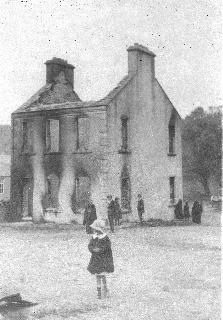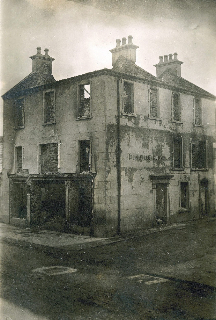THE RINEEN AMBUSH AND THE REPRISALS THAT FOLLOWED
By Colm Hayes.
Early in the morning of 22nd September 1920 about 50 men of 4th Battalion, Mid Clare Brigade moved into place at Drummin Hill, Rineen, halfway between Lahinch and Miltown Malbay. Their mission was to attack a police lorry that travelled regularly from Ennistymon to Miltown. Scouts were positioned for about a mile before the ambush site and about noon, they began to signal that the police lorry was coming. However a mix-up in the transfer of the message meant that the signal given to the attacking party was that three lorries were approaching. The Battalion Commander, Ignatius O’Neill immediately gave the order to let the lorries pass. He felt that his attacking force was not strong enough to deal with three lorries. The volunteers had only about 12 rifles and the same number of shotguns.
However despite the mistake, O’Neill knew that the lorry would return, so the battalion remained in place. Three hours later the lorry made the return journey and when it reached Rineen, riflemen on each side of the road opened fire immediately killing the driver and within minutes all six occupants of the lorry were killed including one who managed to escape but he was pursued and killed.
The Volunteers immediately began collecting rifles, revolvers and ammunition from the lorry. While they were engaged in this, a shout when up that two lorries of British soldiers were approaching the ambush site from the Ennistymon direction. Orders were given to the men to disperse and most headed towards the top of Rineen hill while a few went in the opposite direction towards the sea.
The arrival of the troops was a coincidence. They were searching for a Magistrate, Capt. Alan Lendrum who had left Kilkee by car that morning for the Petty Session Court in Ennistymon, but had not arrived long after the scheduled start time.
A battle soon began between the Volunteers on the hilltop and the heavily armed British soldiers. All the volunteers successfully withdrew across the countryside despite coming under machine gun fire from the soldiers - the only casualty being Ignatius O’Neill who was wounded in the thigh but was carried to safety by Michael O’Dwyer.
Vengeance was soon on the minds of the British soldiers. The first victim was John Keane, a local farmer, who was drawing hay close to the ambush site. He was fired on and killed by the soldiers who also burned a number of houses in the locality.
That night brutal reprisals were carried out by the soldiers and some Black and Tans on the defenceless inhabitants of Ennistymon, Lahinch and Miltown Malbay. Many people had fled the three towns in anticipation of reprisals but most had to brace themselves for the onslaught of the vengeful Crown forces. The attack on Ennistymon began about 9pm when the Town Hall on Parliament Street was burned using incendiary bombs and petrol. Across the road, the home of a tailor John Whelan was then set on fire and totally gutted. The soldiers then went to the home of Tom Connole on Circular Road. He and his wife and two small children were taken from their home which was set on fire. Tom Connole was shot by the soldiers and his body thrown into his burning house. The soldiers then headed up the Kilcornan Road to the home of Thomas Nestor, whose son Miko had taken part in the Rineen ambush earlier that day and was not at home. The family was ordered out of the house and it was destroyed by fire.
Returning to Main Street, the public house of Patrick Madigan was attacked and looted by the soldiers. Having consumed the liquor they had stolen, they continued their destructive rampage through the town. They smashed the windows of a number of shops and houses and then set fire the residence of James Devitt. As the fire in Devitt’s took hold, the soldiers went further down Main Street and proceeded to attack and loot the drapery shop also owned by James Devitt. Meanwhile the fire in the Devitt residence was burning fiercely and began to spread to Marrinan’s house next door. A number of young men bravely attempted to fight the fire with buckets of water but were spotted by the soldiers who captured 21 years old, P.J. Linnane, while the other men escaped. P.J. Linnane was beaten down Main Street into Parliament Street and was shot at the entrance to Markham’s Lane beside the Courthouse and then dragged into the lane where he died.
The soldiers next targeted Thomas Callinan’s public house in Church Street which was looted and burned. They then set fire and destroyed the corner house of John Clair, whose son Michael Clair was a prominent member of the Volunteers in Ennistymon. The soldiers continued their work of destruction by burning to the ground the home Seamus Conneely, a prominent Republican who was then on the run.
Having wreaked havoc on Ennistymon, the British military then turned their violent assault on Lahinch. It was after 1 o’clock in the morning when the soldiers began their attack on the resort. Parties of unformed men in motor lorries went up and down the town firing shots indiscriminately and setting fire to houses. The residents were terror-stricken and fled in dozens to the Sandhill’s in cold damp conditions.
The soldiers broke into Iona Lodge, a boarding house owned by Patrick Walsh and ordered the residents out before setting fire to the house. They detained one of the guests, Joseph Sammon, a native of Feakle. Next morning his body was found near the house with bullet wounds to the head. John Reynolds lived next door to Walsh’s and his house was severely damaged.
The home of Thomas and Bridget Flanagan who ran a spirit and grocery business on Main Street was attacked by the soldiers breaking the windows and looting the contents before setting fire to the building. Thomas and Bridget had to flee to Sandhill’s. An adjoining section of the house was the home of Susan Flanagan, Thomas’ sister, and on the ground floor was a bakery run by Susan’s other brother Johnny with Mattie and Paddy Rush. Also in the house was Susan’s invalid sister Bridget and when the soldiers came in, Susan was forced to carry Bridget to safety as the house was set ablaze. Local Volunteer, Pake Lehane who participated in the Rineen Ambush, had taken refuge in Flanagan’s House that night and when the house was set on fire, he was burned to death.
Further up the street the house of Michael Vaughan suffered a similar fate. After ordering the residents out, the soldiers threw incendiary bombs into the house which soon was engulfed in flames.
In the centre of Lahinch was the business premise of the O’Dwyer family, Tigh Baile an Gleanna (Glenville House). In the house that night was Máire O’Dwyer, her aunt Nora and niece Mary. Máire was Officer Commanding the 4th Battalion of Cumann na mBan, a very senior position in the republican movement, which would have been known to the marauding soldiers. The occupants of Glenville House received no warning to vacate the premises as incendiary bombs engulfed the house, forcing the family to flee for their lives.
Other buildings attacked and looted were the bakery of James Glynn and the house of Pat O’Donnell. Matt Reynolds had a family of nine in his house. The family were given minutes to vacate the house before it was doused with petrol and set alight. The house and all its contents were completely destroyed.
The Victoria Hotel owned by Thomas Blackwell was attacked by the military that broke down the front door and set fire to the hallway. Guests in the hotel managed to escape through the windows. Mr. Blackwell pluckily fought the flames and saved the building from total destruction though a portion of the interior and its contents were wrecked.
The Town Hall owned by Margaret Collins of the Marine Hotel was also burned on that fateful night. When the soldiers arrived at the Hotel, Miss Collins pleaded that it should be spared, as it was solely occupied by ladies and that she had suffered enough with the loss of the Town Hall. The soldiers moved away and Miss Collins was able to offer refuge to a number of terrified women and children who were outside.
Howard’s Hotel was attacked by the soldiers who gave Michael Howard, his family and hotel guests very little time to vacate the premises as the building was consumed by fire and totally burned. The soldiers then made their way to the house of Dan and Margaret Lehane outside Lahinch. They were ordered to leave the house which was then set on fire. As they moved away from the house, Dan was shot twice in the head. He lived for another month and died on 23rd October as a result of these wounds. Dan and Margaret Lehane’s son Pake had died in the fire in Flanagan’s earlier that night.
The reprisals began in Miltown Malbay about 11.30pm when the sound of rifle shots was heard and soldiers were seen passing through the streets shouting, striking doors and shutters and breaking windows with the butts of their rifles. It was no surprise that one of the first houses targeted was the home and business of
Patrick H. O’Neill, father of Ignatius O’Neill, O/C of the 4th Battalion.
The soldiers had come with a plentiful supply of petrol and incendiary devices, as none of the houses attacked lasted more than half an hour before collapsing. Having set fire to O’Neill’s, the military then targeted the licensed premises of Edward Roche. Mrs. Roche and a neighbour Anne Hogan were in the house when the assault began. They managed to escape through the smoke and flames into a back yard. The drapery and licensed premises of the Collins family was next to be burned. The family was forced to flee for their lives as the house went up in flames. Michael Casey’s drapery shop was next door to Collins’ and both business’ were burned in the same fire. In Church Street, the licensed premises of Austin Jones was attacked and set on fire. The building was totally gutted. When the house of Mrs. Bridget Marrinan was set alight, her invalided son was trapped in the house, and it was with great difficulty that he was rescued. The home of William Hynes, the postmaster in Miltown Malbay was attacked and looted and the garage of Dr. Hillery was forcibly entered and a Ford car was set on fire and much damaged done.
As dawn broke, shocked and traumatised inhabitants witnessed scenes of destruction in Ennistymon, Lahinch and Miltown Malbay. Fires still smoldered in burned out houses and people returned to their homes with great trepidation. Eleven people had died and another was mortally wounded in a twenty-four hour period that is deeply engrained in the collective memory one hundred years later.
NORTH CLARE’S FIGHT FOR IRISH FREEDOM, newly published book by Colm Hayes, now available in bookshops or from hayesprint@hotmail.com


